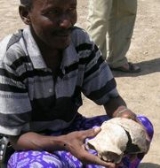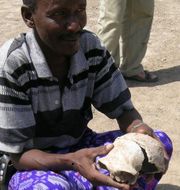
Gawis cranium
Encyclopedia
The Gawis cranium is a hominid skull discovered on February 16, 2006 near the drainage of Gawis, a tributary of the Awash River
in the Afar Depression
, Ethiopia
. The skull despite volcanic ash layers which hold the key to dating is dated very sparsely between 200,000 and 500,000 years due to unfortunate taphotomic
properties.
The 2006 discovery was reported by Sileshi Semaw, director of the Gona Project, who is based at the Stone Age Institute and IU Bloomington's CRAFT research center, who suspect the skull could be a transitional fossil
that fills a gap in human evolutionary origins, describing it as appearing to be an intermediate species between Homo erectus
and Homo sapiens.
 The skull was discovered by Asahmed Humet, a member of the Gona Paleoanthropological Research Project. Asahmed Humet found in small erosion gully a recently resurfaced fossil. The erosion gully empty to the Gawis river drainage basin in the Afar Region
The skull was discovered by Asahmed Humet, a member of the Gona Paleoanthropological Research Project. Asahmed Humet found in small erosion gully a recently resurfaced fossil. The erosion gully empty to the Gawis river drainage basin in the Afar Region
, 300 miles northeast of Addis Ababa. The skull is a nearly complete cranium of what is believed to be a Middle Pleistocene
human ancestor. While different from a modern human, the braincase, upper face and jaw of the cranium have unmistakable anatomical evidence that belong to human ancestry.
Significant archaeological collections of stone tools and numerous fossil animals were also found at the site.
The discovery was reported by Sileshi Semaw, director of the Gona Project, who is based at the Stone Age Institute
, but is difficult to find report related publication
Gawis is in the Gona Research Project study area, which is in the Awash River Valley. Immediately to the east of Gona, also located along the Awash and one of its tributaries is the site of Hadar
, where U.S. scientist Donald Johanson
found the 3.2 million year old remains of an Australopithecus afarensis
, known as Lucy
, in 1974. The Middle Awash
, site of many other hominid discoveries, is to the south.
In addition to the Gawis cranium, the Gona project area is where the world's oldest stone tools (2.6 million years old) were discovered, as well as fossils of Ardipithecus ramidus dated to approximately 4.5 million years ago.
Awash River
The Awash is a major river of Ethiopia. Its course is entirely contained within the boundaries of Ethiopia, and empties into a chain of interconnected lakes that begin with Lake Gargori and end with Lake Abbe on the border with Djibouti, some 100 kilometers from the head of the Gulf of Tadjoura...
in the Afar Depression
Afar Depression
The Afar Triangle is a geological depression that is caused by the Afar Triple Junction which is part of the Great Rift Valley. It overlaps Eritrea, Djibouti and the entire Afar Region of Ethiopia. The Afar Triangle includes the Danakil Depression and the lowest point in Africa, Lake Asal...
, Ethiopia
Ethiopia
Ethiopia , officially known as the Federal Democratic Republic of Ethiopia, is a country located in the Horn of Africa. It is the second-most populous nation in Africa, with over 82 million inhabitants, and the tenth-largest by area, occupying 1,100,000 km2...
. The skull despite volcanic ash layers which hold the key to dating is dated very sparsely between 200,000 and 500,000 years due to unfortunate taphotomic
Taphonomy
Taphonomy is the study of decaying organisms over time and how they become fossilized . The term taphonomy was introduced to paleontology in 1940 by Russian scientist Ivan Efremov to describe the study of the transition of remains, parts, or products of organisms, from the biosphere, to the...
properties.
The 2006 discovery was reported by Sileshi Semaw, director of the Gona Project, who is based at the Stone Age Institute and IU Bloomington's CRAFT research center, who suspect the skull could be a transitional fossil
Transitional fossil
A transitional fossil is any fossilized remains of a lifeform that exhibits characteristics of two distinct taxonomic groups. A transitional fossil is the fossil of an organism near the branching point where major individual lineages diverge...
that fills a gap in human evolutionary origins, describing it as appearing to be an intermediate species between Homo erectus
Homo erectus
Homo erectus is an extinct species of hominid that lived from the end of the Pliocene epoch to the later Pleistocene, about . The species originated in Africa and spread as far as India, China and Java. There is still disagreement on the subject of the classification, ancestry, and progeny of H...
and Homo sapiens.
Discovery and significance

Afar Region
Afar is one of the nine ethnic divisions of Ethiopia, and is the homeland of the Afar people. Formerly known as Region 2, its current capital is Asayita; a new capital named Semera on the paved Awash - Asseb highway is under construction....
, 300 miles northeast of Addis Ababa. The skull is a nearly complete cranium of what is believed to be a Middle Pleistocene
Middle Pleistocene
The Middle Pleistocene, more specifically referred to as the Ionian stage, is a period of geologic time from ca. 781 to 126 thousand years ago....
human ancestor. While different from a modern human, the braincase, upper face and jaw of the cranium have unmistakable anatomical evidence that belong to human ancestry.
Significant archaeological collections of stone tools and numerous fossil animals were also found at the site.
The discovery was reported by Sileshi Semaw, director of the Gona Project, who is based at the Stone Age Institute
Stone Age Institute
The Stone Age Institute is an independent research center dedicated to the archaeological study of human origins and technological development. The institute conducts research and education in human origins studies, publishes books and articles, and mentors prospective scientists The institute is...
, but is difficult to find report related publication
Gawis is in the Gona Research Project study area, which is in the Awash River Valley. Immediately to the east of Gona, also located along the Awash and one of its tributaries is the site of Hadar
Hadar, Ethiopia
Hadar is a village in Ethiopia, on the southern edge of the Afar Triangle with a latitude and longitude of approximately . The village is known for the nearby archaeological site....
, where U.S. scientist Donald Johanson
Donald Johanson
Donald Carl Johanson is an American paleoanthropologist. Along with Maurice Taieb, and Yves Coppens he is known for the discovery of the skeleton of the female hominid australopithecine known as "Lucy", in the Afar Triangle region of Hadar, Ethiopia.-Early years:Johanson was born in Chicago,...
found the 3.2 million year old remains of an Australopithecus afarensis
Australopithecus afarensis
Australopithecus afarensis is an extinct hominid that lived between 3.9 and 2.9 million years ago. A. afarensis was slenderly built, like the younger Australopithecus africanus. It is thought that A...
, known as Lucy
Lucy (Australopithecus)
Lucy is the common name of AL 288-1, several hundred pieces of bone representing about 40% of the skeleton of an individual Australopithecus afarensis. The specimen was discovered in 1974 at Hadar in the Awash Valley of Ethiopia's Afar Depression. Lucy is estimated to have lived 3.2 million years...
, in 1974. The Middle Awash
Middle Awash
The Middle Awash is an archaeological site along the Awash River in Ethiopia's Afar Depression. A number of Pleistocene and late Miocene hominid remains have been found at the site, along with some of the oldest known Olduwan stone artifacts and patches of fire-baked clay, disputed evidence of the...
, site of many other hominid discoveries, is to the south.
In addition to the Gawis cranium, the Gona project area is where the world's oldest stone tools (2.6 million years old) were discovered, as well as fossils of Ardipithecus ramidus dated to approximately 4.5 million years ago.
See also
- Human evolutionHuman evolutionHuman evolution refers to the evolutionary history of the genus Homo, including the emergence of Homo sapiens as a distinct species and as a unique category of hominids and mammals...
- List of fossil sites (with link directory)
- List of hominina (hominid) fossils (with images)

